英文_翻译讲座
英语讲座翻译
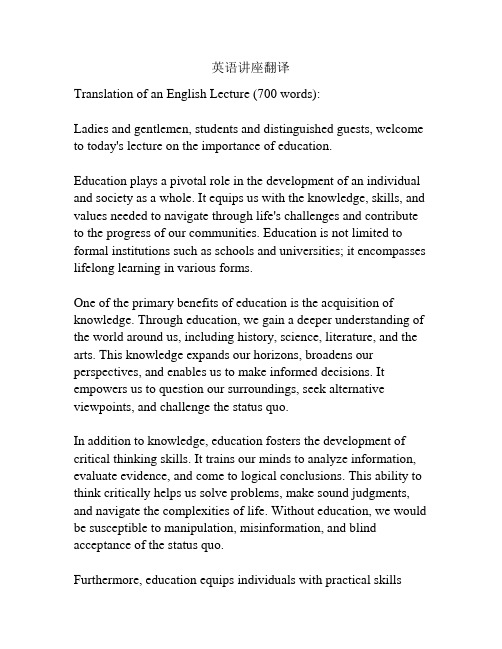
英语讲座翻译Translation of an English Lecture (700 words):Ladies and gentlemen, students and distinguished guests, welcome to today's lecture on the importance of education.Education plays a pivotal role in the development of an individual and society as a whole. It equips us with the knowledge, skills, and values needed to navigate through life's challenges and contribute to the progress of our communities. Education is not limited to formal institutions such as schools and universities; it encompasses lifelong learning in various forms.One of the primary benefits of education is the acquisition of knowledge. Through education, we gain a deeper understanding of the world around us, including history, science, literature, and the arts. This knowledge expands our horizons, broadens our perspectives, and enables us to make informed decisions. It empowers us to question our surroundings, seek alternative viewpoints, and challenge the status quo.In addition to knowledge, education fosters the development of critical thinking skills. It trains our minds to analyze information, evaluate evidence, and come to logical conclusions. This ability to think critically helps us solve problems, make sound judgments, and navigate the complexities of life. Without education, we would be susceptible to manipulation, misinformation, and blind acceptance of the status quo.Furthermore, education equips individuals with practical skillsnecessary for success in the professional world. Whether it is technical or vocational training, education enables individuals to acquire the expertise needed to excel in their chosen fields. It enhances employability and opens doors to better career opportunities. Moreover, education instills values such as perseverance, discipline, and teamwork, which are invaluable in the workplace.Education not only benefits individuals but also has a profound impact on society. By educating its citizens, a society can empower individuals to actively participate in civic life, contributing to the betterment of their communities. Additionally, education promotes social equality by providing equal opportunities for all, regardless of their background, social status, or economic means. It is a powerful tool for breaking the cycle of poverty and promoting social mobility.Public investment in education is crucial for the advancement of any nation. Governments should prioritize allocating adequate resources to ensure quality education for all citizens. Education is not solely the responsibility of the government; it requires the involvement and support of parents, teachers, and the broader community. Collaboration among these stakeholders is essential to create an environment conducive to learning and personal growth. In conclusion, education is the cornerstone of personal and societal development. It empowers individuals, enhances critical thinking skills, and equips them with practical expertise for success. Moreover, education promotes social equality and contributes to the overall progress of a nation. Let us recognize the importance ofeducation and work together to make it accessible and high-quality for all individuals. Thank you.。
语篇翻译主题知识讲座

nostalgia [nɔ'stældʒiə, nə-] n. 乡愁;怀乡病;怀旧之情
§ I saw the old apartment building where I had lived and the playground where I had played. As I viewed these once familiar surroundings, images of myself as a child there came to mind. However, what I saw and what I remembered were not the same I sadly realized that the best memories are those left undisturbed
围,但这么并不能限制我不断探索旳天性。
chute [ʃu:t] n. 斜槽;瀑布;降落伞;陡坡道
hatch [hætʃ] n. 舱口;孵化
confined [kən'faind adj. 幽禁旳;狭窄旳;有限制旳;在分娩中旳v. 限制
§There was a small branch in back of the building where my friends and I would play. We
My Old Neighborhood
§ Several years ago I returned to Washington, D.C., and visited one of my old neighborhoods. I had been on Nash Street for more than twenty years and as I walked along the street, my mind was flooded by waves of nostalgia.
翻译讲座3:英译汉的技巧
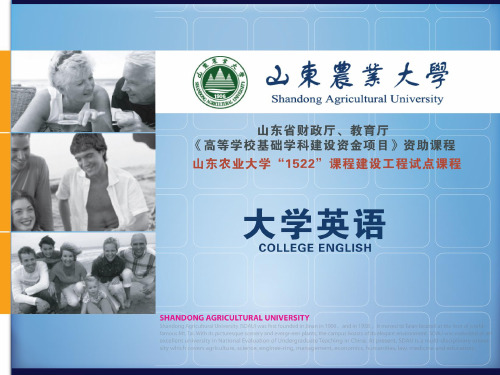
• 6. “What America has lost,” says one veteran observer, “is
第二节 增译法
7. Inflation has now reached unprecedented level. 目前通货膨胀已经发展到空前严重的地步。 (形容词)
8. A fool and his words are soon parted; a man of genius and his money. (并列句中省略的部分)
第三节 减译法
1.Whether the laws are good or bad, they cannot complain, they cannot question, they cannot suggest changes.(作主语的人称代词) 无论法律公正与否,他们无法抱怨、无法质疑、无法建议 修改。 2. He who never reached the Great Wall is not a true man. (表示泛指的人称代词) (物主代词、做宾语的人称代词也可省略)
愚人会很快忘记说过的话,智者会很快放弃手里的钱。 蠢材轻其言,天才轻其财。
第二节 增译法
9. The high-altitude plane was and still is a remarkable bird. (表示时态的词) 该高空飞机过去是,现在仍然是... … 10. A red sun rose slowly from the calm sea. (量词)
第三节 减译法
3. Insufficient power made it difficult to start the motor. (先行代词it) 电力不足,难以使马达启动。 4. Reading furnishes the mind only with materials of knowledge; it is thinking that makes what we read ours. (强调句型中的it) 读书只能给大脑提供知识的材料, 思考才能把我们所读的东西变成自己 的。
专业英语翻译知识讲座二

词义的引申
引申出词语的实际含义:将原文特定的上 一、引申出词语的实际含义 下文中含义清楚,但若直译成汉语则意思不够 清楚或容易造成误解的词语加以引申。 1、However ,colors can give more force to the form of the product.
直译:然而,色彩能给予产品外形以更多的力量。 直译:然而,色彩能给予产品外形以更多的力量。 引申译:然而,色彩能给产品外形增添美感。 引申译:然而,色彩能给产品外形增添美感。
注意:有时词义引申后,为了表达方便,还必须适当改变 注意:有时词义引申后,为了表达方便,
原文的句子结构。如上文中 从句在原文中是定语从句, 原文的句子结构。如上文中that从句在原文中是定语从句, 从句在原文中是定语从句 而在译文中变成了条件壮语。 而在译文中变成了条件壮语。 引申要恰如其分,防止弄巧成拙或曲解原意。例如: 注意 引申要恰如其分,防止弄巧成拙或曲解原意。例如: Without tools man is nothing ,with tools he is all. 直译:没有工具人们就是微不足道的,有了工具人们就了不起。 直译:没有工具人们就是微不足道的,有了工具人们就了不起。 引申译:人没有工具就一事无成,有了工具就无所不能。 引申译:人没有工具就一事无成,有了工具就无所不能。
词义引申练习:
1、Just think of a world without numbers! We couldn’t build houses or cities, or make tractors or ships. 2 、The least ordered organization occurs when the buildings are placed indiscriminately on the site with no effort to coordinate them. 3、Many streets in European medieval villages or towns of today fit this classification of space.
英语八级汉英翻译讲座内容--房子不是家
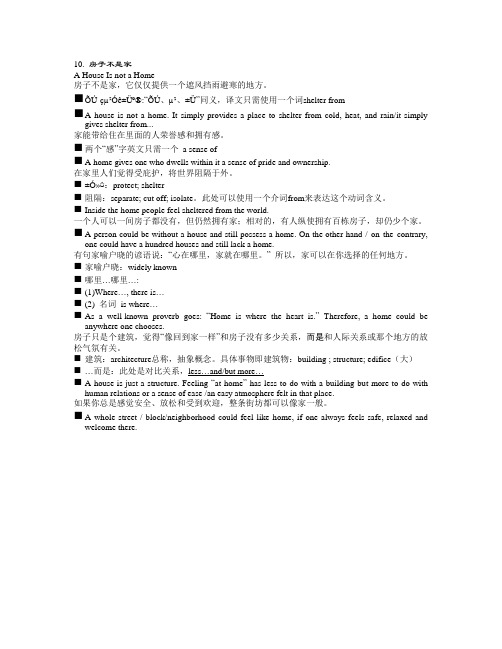
10. 房子不是家A House Is not a Home房子不是家,它仅仅提供一个遮风挡雨避寒的地方。
⏹ÕÚ·çµ²Óê±Üº®:“ÕÚ、µ²、±Ü”同义,译文只需使用一个词shelter from⏹A house is not a home. It simply provides a place to shelter from cold, heat, andrain/it simply gives shelter from...家能带给住在里面的人荣誉感和拥有感。
⏹两个“感”字英文只需一个a sense of⏹A home gives one who dwells within it a sense of pride and ownership.在家里人们觉得受庇护,将世界阻隔于外。
⏹±Ó»¤:protect; shelter⏹阻隔:separate; cut off; isolate。
此处可以使用一个介词from来表达这个动词含义。
⏹Inside the home people feel sheltered from the world.一个人可以一间房子都没有,但仍然拥有家;相对的,有人纵使拥有百栋房子,却仍少个家。
⏹A person could be without a house and still possess a home. On the other hand /on the contrary, one could have a hundred houses and still lack a home.有句家喻户晓的谚语说:“心在哪里,家就在哪里。
”所以,家可以在你选择的任何地方。
CET4翻译专题讲座
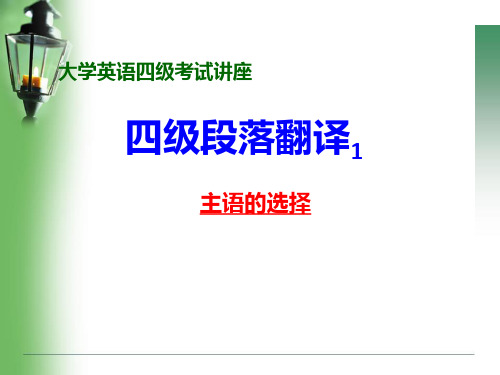
According to Xinhua news agency, the food wasted by Chinese people every year is equal to about 50 million tons of grain. What is more astonishing is that college students waste twice as much food as the national average. To reduce food waste, many college canteens have taken various measures. By adopting measures like improving the food quality and offering small portions, they encourage students to join in the “ eat-up” campaign. These measures have greatly improved students’ awareness of food conservation. Many students said they would do their bit to eliminate food waste.
大学英语四级考试讲座
四级段落翻译1
主语的选择
主语是否为动作的实施者? 现在全世界各地都在学习中国功夫。 Nowadays, Chinese kungfu is being learned all across the world. 中国人交友,最重要的原则是诚和信。 Chinese people try to maintain two most important principles in friendship: sincerity and faithfulness.
考研英语考研英语翻译讲座第11讲模版课件
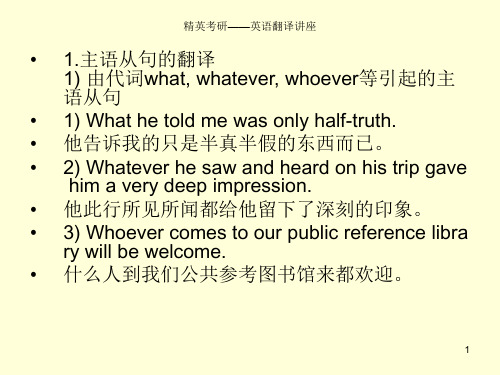
精英考研——英语翻译讲座
• 2) 译作汉语的并列句或平行结构 (1) She sang as she prepared the experim ent.
• 她一边唱着歌,一边准备实验。 (2) They set him free when his ransom had not yet been paid.
• 2) “It” 作为形式主语 1) It doesn’t make much difference whether he attends the meeting or not.
• 他参不参加会议都没多大关系。 2) It seemed inconceivable that the pilot could h ave survived the crash.
• 我们不是在调查他是否可以信任的问题。 2) 译为类似定语的结构或独成一句;如: (1) They were very suspicious of the assumption that he would rather kill himself than surrender.
• 对于他宁愿自杀也不投降这种假设,他们是很怀疑的。 (2) It does not alter the fact that he is the man responsibl e for the delay.
• 她说话时,泪水直流。 (2) Please turn off the light when you leave the room.
• 离屋时请关电灯。 (3) He had scarcely handed me the letter when he asked me to read it.
• 他把信一交给我,就叫我念给他听。
法律讲座英语翻译稿

法律讲座英语翻译稿Legal Lecture English Translation DraftIntroduction:Today, we have gathered here for an informative legal lecture, where we will delve into various legal topics and concepts. In this translation draft, I aim to accurately convey the essence of the lecture while ensuring clarity and readability. Let us begin!Legal Basics:The first segment of the lecture focused on fundamental legal principles. It highlighted the concept of the rule of law, emphasizing its importance in maintaining a just and fair society. Additionally, the lecturer touched upon the different branches of law, including civil law, criminal law, and administrative law.Contract Law:Moving on, the lecture progressed to a crucial area of law - contract law. The lecturer provided a comprehensive overview of contract formation, its essential elements, and the significance of mutual assent. Key terms such as offer, acceptance, consideration, and legality were discussed in detail.Moreover, the lecture shed light on the various types of contracts, such as express contracts and implied contracts. Specific attention was given to the importance of written contracts and the concept of enforceability. The lecturer emphasized the significance of clear and unambiguous contract terms to avoid potential disputes.Tort Law:Another significant topic covered during the legal lecture was tort law. The lecture aimed to help the audience understand the basics of torts, including different types and their elements. The lecturer explained how tort law provides remedies for various personal and property-related harms.Furthermore, the lecture delved into negligence as a common tort and covered the four elements required to prove negligence: duty of care, breach of duty, causation, and damages. The audience gained insights into how negligence cases are evaluated and the role of reasonable foreseeability in determining liability.Criminal Law:Shifting gears, the lecture proceeded to criminal law, capturing the audience's attention with its intriguing scenarios and examples. The lecturer familiarized the audience with the key principles of criminal law, including mens rea (mental state) and actus reus (guilty act). The importance of evidence in criminal cases was emphasized, along with the burden of proof resting on the prosecution.Moreover, the lecture touched upon different categories of crimes such as violent crimes, property crimes, and white-collar crimes. The audience gained insights into the criminal justice system, including the stages of a criminal trial and the roles of key actors such as judges, prosecutors, and defense attorneys.Intellectual Property:In the intellectual property section of the lecture, the audience was introduced to the field of IP law, which protects creations of the mind. The lecturer discussed the various types of intellectual property, such as patents, copyrights, trademarks, and trade secrets.The lecture explored the purpose of intellectual property rights, highlighting how they encourage innovation and creativity. Additionally, the lecturer addressed the importance of intellectual property infringement, its potential consequences, and the available legal remedies.Conclusion:As the legal lecture drew to a close, the audience left with a deeper understanding of essential legal concepts and principles. The translation draft captured the essence of the lecture, ensuring accurate and informative content. Remember, the law plays a vital role in society, shaping our interactions, rights, and responsibilities. Stay informed, be aware of your legal obligations, and continue to expand your legal knowledge.。
翻译讲座

大学英语四级辅导讲座:汉英翻译技巧 大学英语四级辅导讲座:
例句分析 4. _________________ ( 就经济发展而言 就经济发展而言), China has made outstanding achievement in the past twenty years. (Model Test 1 No.90)
大学英语四级辅导讲座:汉英翻译技巧 大学英语四级辅导讲座:
二、翻译三要素
1、关键词语(一般由两个词或词组组成 、 一般由两个词或词组组成) 2、关键句型,结构: (强调;倒装;从句;it 、关键句型,结构: 强调;倒装;从句; 用法;虚拟语气等) 用法;虚拟语气等) 3、时态/语态 、时态 语态
大学英语四级辅导讲座:汉英翻译技巧 大学英语四级辅导讲座:
大学英语四级辅导讲座:汉英翻译技巧 大学英语四级辅导讲座:
例句分析 2. Only by working at evenings and weekends _________________.( 他才能完成报告 他才能完成报告)(Model Test 1 No.88)
is he able to finish/complete the report
例句分析 1.Your father is the president of the bank, but that doesn’t mean _________________.( 你有 资格在这里工作)(Model Test 1 No.87) 资格在这里工作
be entitled to/have the right to/be qualified to ---you are entitled to work here ---you have the right to work here ---you are qualified to work here
英语八级汉英翻译讲座(含名篇15篇)

练习1徐霞客*徐霞客一生周游考察了十六个省,足迹几乎遍及全国。
他在考察的过程中,从来不盲目迷信书本上的结论。
他发现前人研究的地理的记载有许多不很可靠的地方。
为了进行真实细致的考察,他很少乘车坐船,几乎全靠双脚翻山越岭,长途跋涉;为了弄清大自然的真相,他总是挑选道路艰险的山区,人迹稀少的森林进行考察,发现了许多奇山秀景;他常常选择不同的时间和季节,多次重游各地名山,反复观察变换的奇景。
徐霞客一生周游考察了十六个省,足迹几乎遍及全国。
*周游:到各处游历; 走遍travel across (around);tour;visit*考察: explore; make an on-the-spot investigation; inspect*足迹:footprint;footmark; trace*遍及spread all over*During his life time, Xu Xiake visited and explored 16 provinces, leaving his footprints in nearly every corner of the country.他在考察的过程中,从来不盲目迷信书本上的结论。
*他在考察的过程中: in his exploration; in his tours;on his tours*盲目:blindly; in a blind way; without thinking*迷信: superstition; blindly worship/ believe in。
*这里“迷信”指接受accept readily/without thinking*He never blindly accepted the conclusions given in books in his exploration.他发现前人研究的地理的记载有许多不很可靠的地方。
*前人:predecessor; forefathers; others*前人栽树,后人乘凉。
讲座英文介绍带翻译
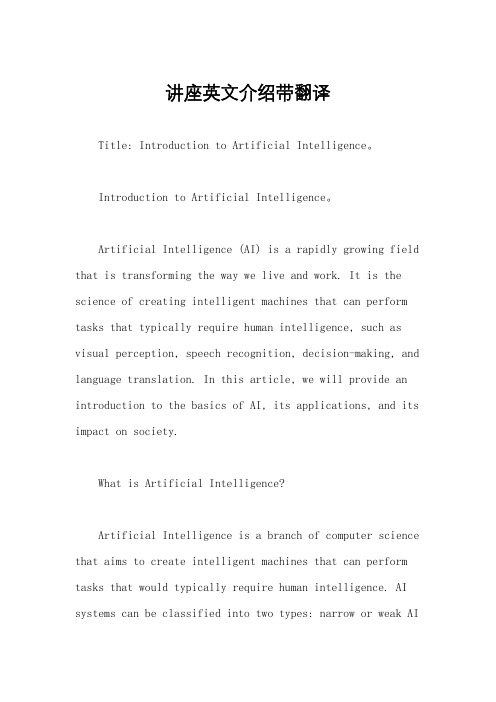
讲座英文介绍带翻译Title: Introduction to Artificial Intelligence。
Introduction to Artificial Intelligence。
Artificial Intelligence (AI) is a rapidly growing field that is transforming the way we live and work. It is the science of creating intelligent machines that can perform tasks that typically require human intelligence, such as visual perception, speech recognition, decision-making, and language translation. In this article, we will provide an introduction to the basics of AI, its applications, and its impact on society.What is Artificial Intelligence?Artificial Intelligence is a branch of computer science that aims to create intelligent machines that can perform tasks that would typically require human intelligence. AI systems can be classified into two types: narrow or weak AIand general or strong AI. Narrow AI is designed to performa specific task, such as facial recognition or language translation. General AI, on the other hand, is designed to perform any intellectual task that a human can do.AI systems use a variety of techniques to simulate human intelligence, including machine learning, natural language processing, and computer vision. Machine learningis a technique that allows machines to learn from data without being explicitly programmed. Natural language processing is the ability of machines to understand and interpret human language. Computer vision is the ability of machines to interpret and analyze visual data.Applications of Artificial Intelligence。
网络安全讲座翻译英文
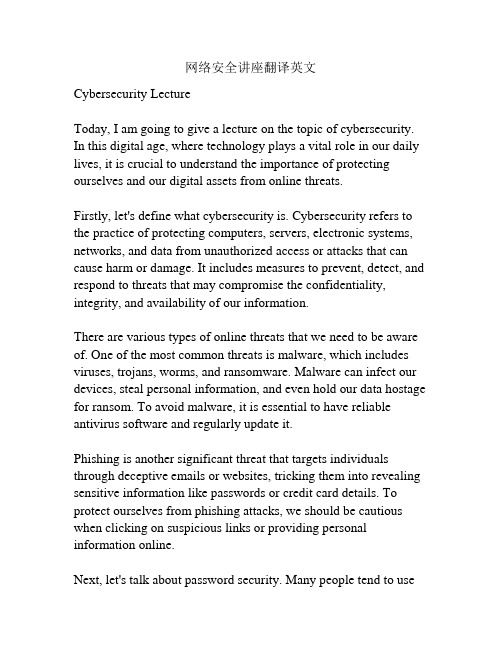
网络安全讲座翻译英文Cybersecurity LectureToday, I am going to give a lecture on the topic of cybersecurity. In this digital age, where technology plays a vital role in our daily lives, it is crucial to understand the importance of protecting ourselves and our digital assets from online threats.Firstly, let's define what cybersecurity is. Cybersecurity refers to the practice of protecting computers, servers, electronic systems, networks, and data from unauthorized access or attacks that can cause harm or damage. It includes measures to prevent, detect, and respond to threats that may compromise the confidentiality, integrity, and availability of our information.There are various types of online threats that we need to be aware of. One of the most common threats is malware, which includes viruses, trojans, worms, and ransomware. Malware can infect our devices, steal personal information, and even hold our data hostage for ransom. To avoid malware, it is essential to have reliable antivirus software and regularly update it.Phishing is another significant threat that targets individuals through deceptive emails or websites, tricking them into revealing sensitive information like passwords or credit card details. To protect ourselves from phishing attacks, we should be cautious when clicking on suspicious links or providing personal information online.Next, let's talk about password security. Many people tend to useweak passwords that are easy to guess, making it easier for hackers to gain unauthorized access to our accounts. It is crucial to create strong passwords that are unique and contain a combination of letters, numbers, and special characters. Furthermore, we should avoid reusing passwords for multiple accounts and regularly change them to enhance security.Another important aspect of cybersecurity is keeping our devices and software up to date. Software developers regularly release updates that fix security vulnerabilities, so it is essential to install these updates promptly. Neglecting to update our devices can make them more susceptible to attacks.Additionally, we should be cautious when connecting to publicWi-Fi networks. Public Wi-Fi networks are often unsecured, making it easier for hackers to intercept our data. It is advisable to use a virtual private network (VPN) when connecting to public networks to encrypt our data and enhance our privacy.Lastly, I would like to emphasize the importance of educating ourselves about cybersecurity. By staying informed about the latest threats and best practices for online safety, we can better protect ourselves and our digital presence. There are many reputable sources, such as cybersecurity websites and organizations, that provide valuable information and resources on this topic.To conclude, cybersecurity is of utmost importance in our modern era. It is crucial to be aware of the various online threats and take proactive measures to safeguard our devices and data. By following best practices, such as using strong passwords, beingcautious online, and keeping our software up to date, we can reduce the risk of falling victim to cyber-attacks. Remember, prevention is always better than cure when it comes to cybersecurity.。
一场书法讲座英文翻译作文

一场书法讲座英文翻译作文Title: A Calligraphy Lecture。
Calligraphy, the art of beautiful writing, has long captivated the hearts and minds of people around the world. Its intricate strokes and elegant curves tell stories of culture, tradition, and creativity. Today, in this lecture, we delve into the essence of calligraphy, exploring its history, techniques, and significance.Firstly, let us journey back in time to ancient China, where calligraphy emerged as a revered art form. Dating back thousands of years, calligraphy initially served as a means of communication, with inscriptions carved into oracle bones and bronze vessels. Over time, it evolved into a sophisticated art practiced by scholars and artisans alike. Chinese calligraphy is characterized by its emphasis on brushwork, rhythm, and balance, with each stroke imbued with meaning and expression.As calligraphy spread across East Asia, it took on unique forms in Japan and Korea, reflecting the distinct cultural identities of each region. Japanese calligraphy, known as "shodo," emphasizes simplicity and spontaneity, with artists often using bamboo brushes and sumi ink to create bold, expressive strokes. Korean calligraphy, or "hanja," combines elements of Chinese and native script, with a focus on harmony and discipline in brushwork.In the Western world, calligraphy found its own voice, with artists experimenting with different styles and techniques. From the intricate illuminated manuscripts of medieval Europe to the modernist explorations of the 20th century, calligraphy has continued to evolve and inspire new generations of artists.Now, let us turn our attention to the techniques of calligraphy. Whether using a brush, pen, or even digital tools, the principles of calligraphy remain the same: precision, control, and rhythm. Each stroke must be carefully considered, flowing seamlessly into the next to create harmonious compositions. Practice is essential inmastering calligraphy, as artists strive to achievefluidity and grace in their writing.Beyond its aesthetic appeal, calligraphy holds deep cultural and spiritual significance. In many cultures, calligraphy is not simply a form of artistic expression but a sacred practice, imbued with symbolism and ritual. In Islamic calligraphy, for example, the intricate geometric designs and flowing scripts are used to convey the beauty of the Quranic verses, while in Tibetan calligraphy, the elaborate scripts are seen as manifestations of Buddhist teachings.In conclusion, calligraphy is more than just beautiful writing; it is a window into the rich tapestry of human creativity and expression. Whether practiced in ancient scrolls or modern digital fonts, calligraphy continues to inspire and enchant people around the world. As we continue to explore its depths, may we find new ways to appreciate and celebrate this timeless art form. Thank you.。
网络安全讲座翻译英语
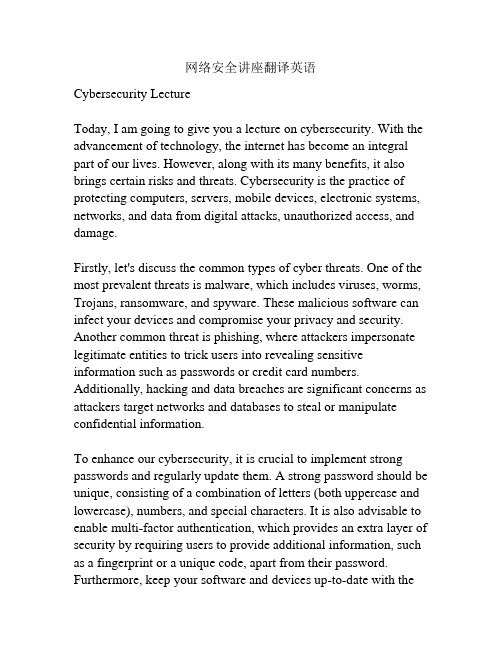
网络安全讲座翻译英语Cybersecurity LectureToday, I am going to give you a lecture on cybersecurity. With the advancement of technology, the internet has become an integral part of our lives. However, along with its many benefits, it also brings certain risks and threats. Cybersecurity is the practice of protecting computers, servers, mobile devices, electronic systems, networks, and data from digital attacks, unauthorized access, and damage.Firstly, let's discuss the common types of cyber threats. One of the most prevalent threats is malware, which includes viruses, worms, Trojans, ransomware, and spyware. These malicious software can infect your devices and compromise your privacy and security. Another common threat is phishing, where attackers impersonate legitimate entities to trick users into revealing sensitive information such as passwords or credit card numbers. Additionally, hacking and data breaches are significant concerns as attackers target networks and databases to steal or manipulate confidential information.To enhance our cybersecurity, it is crucial to implement strong passwords and regularly update them. A strong password should be unique, consisting of a combination of letters (both uppercase and lowercase), numbers, and special characters. It is also advisable to enable multi-factor authentication, which provides an extra layer of security by requiring users to provide additional information, such as a fingerprint or a unique code, apart from their password. Furthermore, keep your software and devices up-to-date with thelatest patches and security updates. Software vendors regularly release these updates to address vulnerabilities and improve security.In addition to protecting our individual devices, it is equally important to secure our home network. Make sure to change the default password of your Wi-Fi router and use WPA2 encryption, which provides a more secure connection. Furthermore, regularly monitor the devices connected to your network and remove any unauthorized ones. Keep an eye out for any suspicious activities or unrecognized devices as they could be signs of a security breach.When it comes to online activities, it is crucial to exercise caution. Be aware of the websites you visit and the links you click on. Verify that the websites you enter sensitive information on have a valid SSL certificate, which ensures that the connection between your device and the website is secure and encrypted. Additionally, refrain from downloading files or software from unknown sources, as they may contain malware. Be mindful of the information you share online, and avoid posting sensitive personal information or location details publicly.Lastly, it is essential to have reliable antivirus and firewall software installed on your devices. These tools provide an extra layer of defense against malware, viruses, and unauthorized access attempts. They continuously monitor your system for any suspicious activities and block potential threats.In conclusion, cybersecurity is of utmost importance in today's digital age. By following the best practices mentioned above, wecan protect our devices, networks, and data from various cyber threats. Stay informed, be cautious, and regularly update your defenses to stay ahead of the ever-evolving cybercriminals. Remember, your security is in your hands.。
考研英语翻译讲座第15讲

精英考研——英语翻译讲座
• • • • • • • • • •
the Book 圣经 a book maker 登记赌注的人 a book of matches 一盒火柴 the visitors book 来客登记簿 to keep books 记账
精英考研——英语翻译讲座
be at one‘s books 埋头功课 • in sb.'s good book • 受宠于某人 • Economics is a good book to me. • 我对经济学一窍不通。 • Her face was an open book. • 她心里有什么事都会在脸上表现出来。
精英考研——英语翻译讲座
• • • • • • • • • •
开汽车 to drive a car 开会 to hold a meeting 开火 to open fire 开价 to offer a price 开灯 to turn on the light 开门 to open the door 开(门)锁 to unlock a door 开收音机 to turn on a radio 开船 to start a boat 开机器 to run a machine.
精英考研——英语翻译讲座
• The Japanese army killed millions of innocent people during the war. • 在那场战争中,日本军队屠杀了成百上千万无辜 的平民。 • Three men were killed in the accident. • 有三名男子在事故中丧生(遇难)。 • The engine was killed by the flood. • 汽车发动机因大水而熄火。 • Your joke nearly killed me. • 你的笑话真是逗死人。 • I'm reading this book just to kill time. • 我读这本书只是为了消磨时间。
新生学习规划和翻译讲座

7. Process
1.Understanding
2.Re-expressing
Three stages
3.Editing
Thank you!
老子《道德经》亦云: 美言不信,信言不美。
广义:指语言与语言,语言与非语言之间的代码转换
和基本信息的转达。
狭义:指一种语言活动,是把一种语言表达的内容忠实
地用另一种语言表达ing is that openeth the window, to let in the light, that breaketh the shell, that we may eat the kernel.(古英语Alfred W.
6.Standard professional criterions
6. Criterions
Three characters “信,达,雅” ——严复《天演论》
1.faithfulness( faithful to the structure/style)
2.expressiveness
3.elegance
Accept Accumulate
A
Await
Abandon
What does “N” stand for?
Nothing is difficult to a man who wills.
Never put off till tomorrow what may be done today.
No cross, no crown.
爱星座,爱打扮,爱唱歌,爱明星 爱淘宝,爱逛街,更爱6厘米高跟鞋 要兼职,要入党,要考证, 要考研,要出国,要拿奖学金 我想遇上那个他,好好爱一场
我是乖乖女
- 1、下载文档前请自行甄别文档内容的完整性,平台不提供额外的编辑、内容补充、找答案等附加服务。
- 2、"仅部分预览"的文档,不可在线预览部分如存在完整性等问题,可反馈申请退款(可完整预览的文档不适用该条件!)。
- 3、如文档侵犯您的权益,请联系客服反馈,我们会尽快为您处理(人工客服工作时间:9:00-18:30)。
句型:使用How來詢問天氣或健康情況範例: A:比爾你好嗎? B:我很好謝謝那你呢?A: How are you, Bill? B: I’m fine. Thank you. And you?A: How are you, Bill? B: Fine, thanks. How are you?講解: (1)詢問別人的健康情形事務的狀態或者是天氣如何均使用下列句型: How+ be動詞+主詞?(2)常見基本問候語形式◆A: Good morning.(afternoon, evening, night, day)B: Good morning.(afternoon, evening, night, day)此句型依時間來決定其用法,而[日安]可用於早上或下午◆A: How are youB: I’m fine. Thank you. And you?此句型為較為熟識的人見面時所使用◆A: How do you do?B: How do you do?此句型於初次見面之人打招呼所使用1.今天天氣如何? 天氣很好。
2.王先生近況如何? 他很好。
3.這枝鋼筆如何?4.李小姐是做什麼的? 她是位英文老師。
5.湯姆,祝你午安。
句型:祈使句的表達方式範例:湯姆要做個好學生Tom ,be a good student.(1)稱呼語, 原形V~ , please.Please 原形V~ , 稱呼語.稱呼語, please原形V~.例: 珍,請坐下Jean, sit down, please. = Please sit down, Jean.= Jean, please sit down.(2)在祈使句中若使用原形動詞”be”,則其否定句依然是在之前加上”Don’t”。
例:上學不要遲到Don’t be late for school.換言之,原形動詞”be”在祈使句的用法和一般動詞相似,故頻率副詞亦置於其前。
1.在用餐時,請不要說太多話。
2.同學們,請打開你們的書來讀3.上班請不要遲到。
4.比爾,請打開電燈。
句型:使用Who來詢問關係或姓名範例:A:在那裡的那個小男孩是誰? B:那是我弟弟A: Who is that little boy over there? B: That is my brother.(1)問某人是誰可用下列句型:Who + be動詞+ 主詞?例:站在那裡的男士是誰? Who is the man standing over there?你的國文老師是誰? Who is your Chinese teacher?(2)Who這個疑問詞可用來問關係或名字,此答句即表示關係。
若是用在問名字,那麼,其意思等於: What + be動詞+ 所有格+ name?例:她叫做什麼名字Who is she? = What is her name?1.這個矮個子的女生是誰? 她是瑪莉。
2.廚房裡的那個女孩是誰? 那是我姊姊。
3.她叫什麼名字? 她叫做珍。
4.在房間讀書的那個男孩是誰? 他是湯姆的弟弟。
5.那個高的男孩是誰? 他的名字叫做喬。
句型:用現在分詞(Ving) 來表示現在進行式。
範例: A:你們正在做什麼? B:我們正在唱歌A: What are you doing? B: We are singing.(1)詢問某人正在做什麼事情?應使用下列句型What +be動詞+ 主詞+ 現在分詞(Ving)?例:瑪莉正在做什麼? What is Mary doing?(2)表示某人正在應使用現在進行式的句型主詞+ be動詞+ 現在分詞(Ving).例:她正在聽音樂。
She is listening to music.(3)使用現在進行是可表動作正在進行及一直持續◆動作正在進行:Tom is playing in the park now.◆動作的持續:You hate English because you aren’t studying it correctly.She is listening to the radio all afternoon.1.李小姐正在黑板上寫什麼?2.他正在讀什麼? 他在讀一本英文書。
3.你正在讀第幾課? 我在讀第六課。
4.這是第幾冊? 這是第二冊。
5.珍正在吃什麼? 他正在吃漢堡。
句型:表示「是…,而不是…」範例:約翰正在讀書不是在玩John is studying, not playing.(1)中文句中「是…,而不是…」相當於因文句型中「…, not…」(2)前後對比的東西必須同一性質或詞性例如: John is tall, not short.Mary is a student, not a teacher.John is at a school, not at home.1.他喜歡在房間裡讀書,而不是客廳。
2.這次考詴很簡單,不難。
3.我們應該使用紙袋,而不是塑膠袋。
4.他正在唱歌,不是在聽音樂。
5.他靜悄悄的走進辦公室,而不是很吵雜。
句型:使用動詞的表示方法範例:桌上有兩本英文書There are two English books on the desk.(1)本句型亦可使用倒裝句的寫法There + be動詞+ 名詞+ 介係詞片語→介係詞片語+ be動詞+ 名詞在倒裝句的寫法中,be動詞支單複數是由後面的名詞來決定。
例:茶几旁邊有一台電視There is a television near the table. 或Near the table is a television.(3)若有特定主詞,要表示[有]的意思時,就必須用動詞”have”或”has” 。
例:我有一本英文字典。
I have an English dictionary.1.在城市裡有各種污染問題。
2.在牆上有一些漂亮的圖畫。
3.他的房間裡到處都是書。
4.公園裡有許多高大的樹木和美麗的花朵。
5.在書桌上有什麼呢? 有一個玻璃杯和一枝鋼筆在上面。
句型:表示沒有的方法範例:客廳裡並沒有沙發There are no sofas in the living room.(1)“There be”開頭的否定句中,否定詞”not”不可直接加上複數名詞或物質名詞,因此,通常使用下列句型: There be動詞+ no + 名詞例:在這所女校中沒有男學生There are no boy students in the girl’s school.例:在這裡冬天沒有雨There is no rain here in winter.(2)在上述句型中的名詞可為單數,但不可在之前加上不定冠詞(a,an),因為no可以換成”not a”或”not any”。
例:書桌上沒有筆There is no book on the desk.或There is not a book on the desk.1.這杯子裡沒有水。
2.在鄉下沒有大的百貨公司。
3.我們都希望未來沒有空氣污染。
4.在這餐廳裡沒有咖啡或茶。
5.現在市場裡沒有蔬菜了。
句型:詢問年紀及表達年齡的方式範例:王小姐今年幾歲了? 她三十多歲了How old is Miss Wang this year?She is more than thirty years old.(1)問年齡有兩種方式:How old + be動詞+ 主詞?What + be動詞+ 所有格+age?(2)表示年齡的句型如下:主詞+ be動詞+ 數字+ year(s) old.主詞+ be動詞+ 數字.主詞+ be動詞+ 數字+ year(s) of age.主詞+ be動詞+ a(an) + 數字- year- old +名詞.1.湯姆是一位十歲大的男孩。
2.你妹妹幾歲了? 十多歲了。
3.你猜李小姐幾歲了。
4.他不喜歡告訴別人他年紀多大。
5.我明年就十六歲了。
句型:詢問怎麼了?的表示法及””的特殊譯法範例: A:怎麼了? B:我的手錶不走了A: What’s wrong? B: My watch is not running.(1)表示怎麼一回事的方法可歸納為下列幾種:◆What’s wrong with +名詞(人或物)?◆What’s the matter with +名詞(人或物)?◆Is there anything wrong with +名詞(人或物)?◆What happened to +名詞(人或物)?例:你的收音機怎麼了?What’s wrong with your radio?→What’s the matter with your radio?→Is there anything wrong with your radio?→What happened to your radio?1.你的鋼筆怎麼了? 它壞掉了。
2.今天早上她怎麼了? 她感冒了。
3.她的腳踏車怎麼了?4.怎麼一回是? 電吉他出了點問題。
5.你的裙子怎麼了? 它被我給燙焦了。
句型:使用”Do you have any+名詞”來表示「某人有任何…」。
範例:你有任何兄弟姊妹嗎?Do you have any brothers and sisters?(1)若表示二人是兄妹可以說:A andB are brother and sister. (不需要在之前加上不定冠詞)類似的說法如下:父子father and son夫妻husband and wife1.比爾有任何的寒假計畫嗎?2.你有任何新的鋼筆嗎?3.瑪莉和約翰是夫妻。
4.假如你有數學方面的任何問題,可以問王先生。
5.他有任何故事的構想嗎?句型:問幾點鐘的表示方法範例:A:第一節課什麼時候開始? B:八點十分開始A: What time dos the first class begin?B: It begins at eight-ten.(1)問「…點…分」可用下列句型:What time + 助動詞+ 主詞+ 原形動詞?What time + be動詞+ 主詞+…?(2)時間的表示法:◆簡讀法:先讀幾點中在讀幾分鐘在已連接線連接幾點-幾分例:十點二十五分ten twenty-five◆詳讀法:在三十分鐘(含)以內先讀幾分鐘再依序寫及點鐘例:六點三十分thirty (minutes) after six (o’clock)九點十五分fifteen (minutes) after nine (o’clock) 超過三十分鐘使用介係詞表示差幾分鐘到下一點整例:五點三十五分twenty-five (minutes) to six (o’clock)1.喬每天幾點鐘起床呢?2.令尊通常幾點鐘去上班?3.你什麼時候要去參加宴會?4.你知道林先生什麼時候會來公司嗎?5.珍常在幾點吃晚飯呢? 他常在七點三十分的時候吃晚飯。
